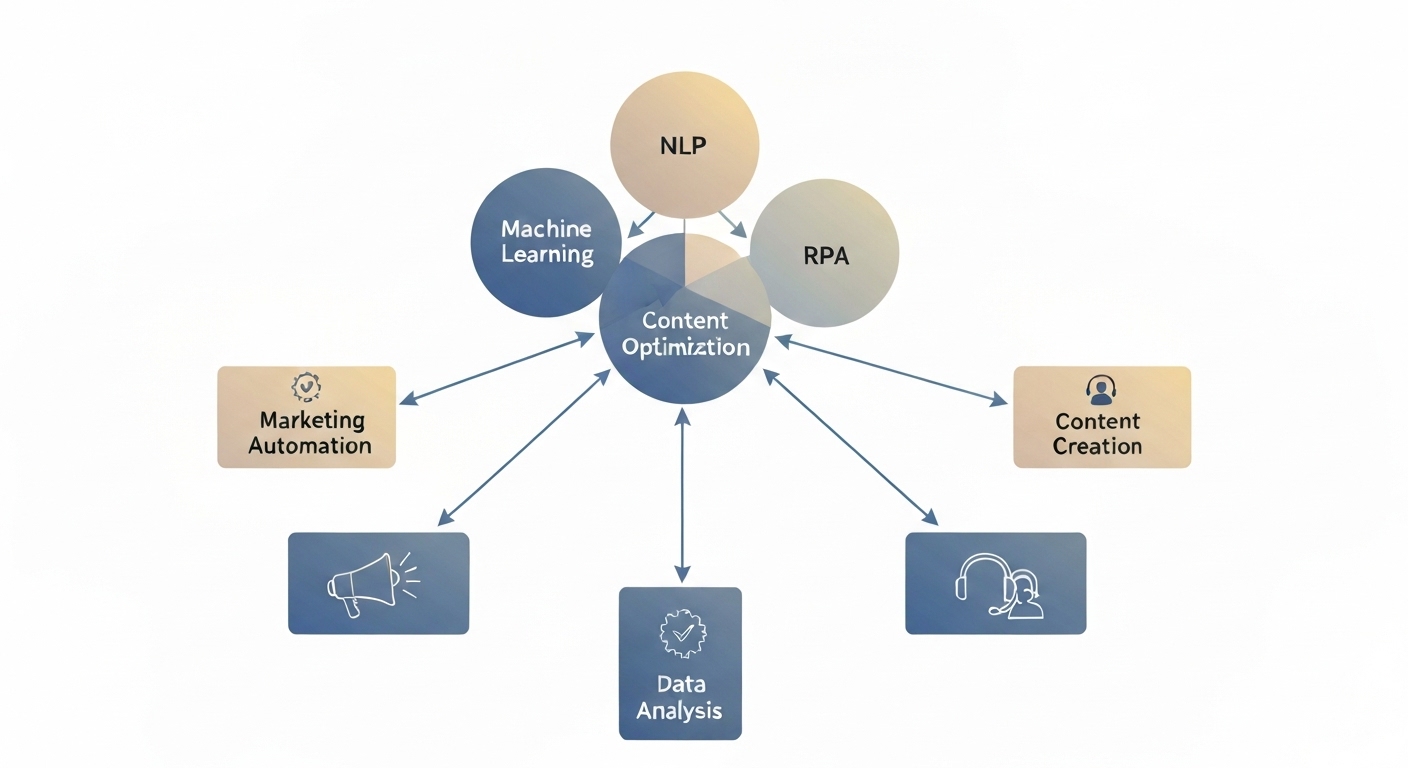Optimizing Business Operations with AI : A Comprehensive Guide
Optimizing business operations with AI is no longer a futuristic concept; it’s a present-day necessity for companies looking to gain a competitive edge. Artificial intelligence offers powerful tools to automate tasks, analyze data, and improve decision-making across various departments.

Understanding the Power of AI in Business
Artificial intelligence (AI) encompasses a range of technologies designed to mimic human intelligence. In a business context, this translates to using AI to automate processes, analyze large datasets, and make predictions. This leads to increased efficiency, reduced costs, and improved customer experiences. Embracing AI requires a strategic approach focused on identifying areas where AI can provide the most significant impact.
The Core Components of AI for Business
- Machine Learning: Enabling systems to learn from data without explicit programming.
- Natural Language Processing (NLP): Allowing computers to understand and process human language.
- Robotic Process Automation (RPA): Automating repetitive tasks using software robots.
- Computer Vision: Enabling machines to “see” and interpret images.
These components work together to create AI solutions tailored to specific business needs.

Identifying Opportunities for Optimizing Business Operations with AI
Before implementing AI, it’s crucial to identify areas where it can have the greatest impact. Consider processes that are time-consuming, repetitive, or prone to human error. Data-rich areas are also prime candidates, as AI excels at extracting insights from large datasets.
Key Areas for AI Implementation
- Customer Service: AI-powered chatbots and virtual assistants can provide 24/7 support.
- Marketing: AI can personalize marketing campaigns and predict customer behavior.
- Sales: AI can analyze sales data to identify leads and improve sales strategies.
- Operations: AI can automate tasks such as inventory management and supply chain optimization.
- Human Resources: AI can streamline recruitment processes and improve employee training.
Successfully integrating AI in these areas requires careful planning and execution.
Implementing AI Solutions for Business Process Optimization
The implementation of AI solutions for business process optimization requires a strategic and phased approach. Starting with a pilot project allows businesses to test and refine their AI strategies before implementing them on a larger scale. It’s also vital to integrate AI with existing systems and train employees to work alongside AI technologies. Optimizing business operations with AI involves careful planning and execution.

Steps for Successful AI Implementation
- Define Clear Objectives: Identify specific goals you want to achieve with AI.
- Gather and Prepare Data: Ensure you have high-quality data to train your AI models.
- Choose the Right AI Tools: Select AI platforms and solutions that align with your business needs.
- Develop and Train AI Models: Build AI models that are tailored to your specific tasks.
- Integrate AI with Existing Systems: Connect AI solutions with your current infrastructure.
- Monitor and Evaluate Performance: Track the performance of your AI models and make adjustments as needed.
The Benefits of AI-Driven Efficiency
AI-driven efficiency offers numerous benefits, including increased productivity, reduced costs, and improved accuracy. By automating repetitive tasks, AI frees up employees to focus on more strategic and creative work. Additionally, AI can analyze data to identify inefficiencies and optimize processes, leading to significant cost savings. The key is strategic implementation of artificial intelligence in business to maximize gains.
Quantifiable Advantages of AI Implementation
- Increased Productivity: Automating tasks leads to faster processing times.
- Reduced Costs: Optimizing processes and minimizing errors reduces expenses.
- Improved Accuracy: AI-driven systems are less prone to human error.
- Better Decision-Making: AI provides data-driven insights for informed decisions.
- Enhanced Customer Experience: AI-powered solutions offer personalized and efficient service.
AI and Data-Driven Decision Making
AI transforms data into actionable insights, enabling data-driven decision making across all levels of the organization. By analyzing vast amounts of data, AI can identify trends, patterns, and anomalies that would be impossible for humans to detect manually. This allows businesses to make more informed decisions and respond quickly to changing market conditions. Data-driven decision making is crucial when optimizing business operations with AI.
Harnessing the Power of Predictive Analytics
Predictive analytics, powered by AI, enables businesses to forecast future trends and outcomes. This can be used to optimize inventory levels, predict customer churn, and identify potential risks. By anticipating future events, businesses can make proactive decisions that improve their bottom line.

Addressing the Challenges of AI Implementation
While the benefits of AI are significant, implementing AI solutions also presents challenges. These include data quality issues, lack of skilled personnel, and integration complexities. Addressing these challenges requires a comprehensive approach that includes data governance, training programs, and strategic partnerships. Successful AI implementation involves overcoming these hurdles.
Overcoming Common AI Implementation Hurdles
- Data Quality: Ensure data is accurate, complete, and consistent.
- Skills Gap: Invest in training programs to develop AI expertise.
- Integration Complexities: Plan carefully to integrate AI with existing systems.
- Security Concerns: Implement robust security measures to protect data.
- Ethical Considerations: Address ethical concerns related to AI bias and transparency.
The Future of Optimizing Business Operations with AI
The future of optimizing business operations with AI is promising. As AI technology continues to evolve, it will become even more integrated into various aspects of business. From personalized customer experiences to autonomous supply chains, AI will play an increasingly important role in driving innovation and growth. Businesses that embrace AI will be well-positioned to thrive in the digital age. AI solutions for business will continue to advance and become more sophisticated.

Real-World Examples of AI Success
Numerous companies have successfully implemented AI to optimize their business operations. For example, retailers are using AI to personalize product recommendations and optimize pricing strategies. Manufacturers are using AI to monitor equipment performance and predict maintenance needs. Financial institutions are using AI to detect fraud and assess credit risk. These examples demonstrate the wide range of applications for AI in business.
Understanding how these companies have implemented AI can provide valuable insights for your own AI initiatives.
AI Implementation in Supply Chain Management
Supply chain management is ripe for AI disruption. From forecasting demand to optimizing logistics, AI can streamline every aspect of the supply chain. AI-powered systems can analyze historical data, weather patterns, and market trends to predict demand with greater accuracy. This allows businesses to optimize inventory levels and reduce waste. Furthermore, AI can optimize shipping routes and delivery schedules, reducing transportation costs and improving delivery times. The benefits of AI in supply chain optimization are significant.
For example, AI algorithms can identify potential disruptions in the supply chain, such as supplier delays or natural disasters, and automatically adjust plans to minimize the impact.
Enhancing Customer Experience with AI
AI is transforming the way businesses interact with their customers. AI-powered chatbots can provide instant customer support, answering questions and resolving issues 24/7. AI can also personalize the customer experience by recommending products and services based on individual preferences. By analyzing customer data, AI can identify patterns and predict customer behavior, allowing businesses to proactively address customer needs. This leads to increased customer satisfaction and loyalty. Optimizing business operations with AI heavily impacts customer relations.
AI can also improve the efficiency of customer service agents by providing them with real-time insights and recommendations. This allows agents to resolve issues more quickly and effectively.
The Ethical Considerations of AI in Business
As AI becomes more prevalent in business, it is important to consider the ethical implications. AI algorithms can be biased if they are trained on biased data, leading to unfair or discriminatory outcomes. It is crucial to ensure that AI systems are fair, transparent, and accountable. Businesses should also consider the impact of AI on employment and take steps to mitigate any negative consequences. A thoughtful approach is needed when implementing artificial intelligence in business.
Transparency and explainability are key to building trust in AI systems. Businesses should strive to make their AI algorithms understandable and explainable to stakeholders.
Getting Started with AI: A Practical Guide
If you’re ready to start optimizing business operations with AI, here are some practical steps to follow:
- Assess Your Business Needs: Identify areas where AI can provide the most value.
- Build a Data Foundation: Ensure you have high-quality data to train your AI models.
- Start Small: Begin with a pilot project to test and refine your AI strategy.
- Partner with Experts: Work with AI consultants or vendors who have experience in your industry.
- Train Your Employees: Provide training to help your employees work effectively with AI.
- Monitor and Evaluate: Track the performance of your AI systems and make adjustments as needed.
By following these steps, you can successfully implement AI and reap the benefits of increased efficiency, reduced costs, and improved customer experiences. You can also explore various AI solutions for business to find the right fit for your company.
To learn more about cloud computing and AI integration, visit flashs.cloud.
Consult reputable sources such as NIST to ensure compliance and best practices.
In conclusion, optimizing business operations with AI is a transformative opportunity for organizations of all sizes. By understanding the power of AI, identifying opportunities for implementation, and addressing the associated challenges, businesses can unlock significant benefits and gain a competitive edge. The journey toward AI adoption may require effort and investment, but the long-term rewards are well worth it.
HOTLINE
+84372 005 899


